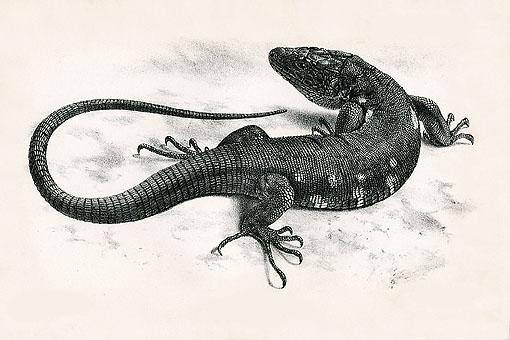|
El Hierro Giant Lizard (Gallotia simonyi) - Wiki
| 제목: | El Hierro Giant Lizard (Gallotia simonyi) - Wiki
| |

| 해상도: 510x340
파일크기: 34059 Bytes
등록시간: 2007:02:06 23:29:42
|
El Hierro Giant Lizard
From Wikipedia, the free encyclopedia
[Photo] Lacerta simonyi = Gallotia simonyi. Artist: P. J. Smit. From: Proceedings of the Zoological Society of London, 1891 http://www.classicnatureprints.com/pr.PZS%20Fauna/pzs.lacerta.simonyi.html
The El Hierro Giant Lizard Gallotia simonyi (or Hierro Giant Lizard; in Spanish, Lagarto Gigante de El Hierro) is a species that can be found on the island of El Hierro, one of the Canary Islands (Spain). The species was once present throughout much of the island and on the small offshore Roque Chico de Salmor, but is now confined to a small areas of cliff with sparse vegetation. It is currently restricted to the southern end of the Risco de Tibataje, in la Fuga de Gorreta, located between Guinea and the so-called Paso del Pino (an area of about four hectares). The species was successfully reintroduced to the Roque Chico de Salmor in 1999, and subsequent reintroductions have taken place at Julan and at la Dehesa.
The about two foot (0.6 m) long El Hierro giant lizard is a thickset reptile with a broad head. Adults are dark grey to brown in colour, with two rows of pale orange patches running along its sides. Its belly is mostly brown, but has an orange to red colouration towards the middle. Older El Hierro Giant Lizards are mainly black with some grey. Males are larger than females.
The El Hierro giant lizard is omnivorous. It eats plants and insects. Mating begins in May and the 5 to 13 eggs are laid from June until the end of August. Their eggs hatch after 61 days.
Subspecies
Two subspecies are recognised, namely the El Hierro Giant Lizard (Gallotia simonyi machadoi L??pez-Jurado, 1989), and the extinct Roque Chico de Salmor Giant Lizard (Gallotia simonyi simonyi Steindachner, 1889). Previously, Gallotia simonyi included the subspecies auaritae but this lizard is now treated as a full species, the La Palma Giant Lizard (Gallotia auaritae).
Endangered
The population of this species is about 300 to 400 animals in the wild (including re-introduced populations), and it is classified as Critically Endangered by the 2006 IUCN Red List. This giant lizard's major threat is predation by feral cats, and possibly also by dogs and rats. The extinct subspecies Gallotia simonyi simonyi that previously occurred on the Roque Chico de Salmor was extirpated in the 1930s through the overcollection of animals for scientific institutions and commercial interests.
A recovery plan for the El Hierro Giant Lizard has been developed and the United Nations and the Canary Islands Autonomous Government funded a program for the captive breeding and re-introduction of the Hierro giant lizard to its original natural habitat. Control of feral cats has been stopped in 2002, but according to the IUCN continued control of feral cats should be resumed to allow population recovery.
The El Hierro Giant Lizard is protected by national and international legislation. It is listed on Annex IV of the European Union's Habitats Directive and on Appendix I of CITES.
http://en.wikipedia.org/wiki/El_Hierro_Giant_Lizard
| The text in this page is based on the copyrighted Wikipedia article shown in above URL. It is used under the GNU Free Documentation License. You may redistribute it, verbatim or modified, providing that you comply with the terms of the GFDL. |
|
^o^
동물그림창고 똑똑전화 누리집
^o^
|
|